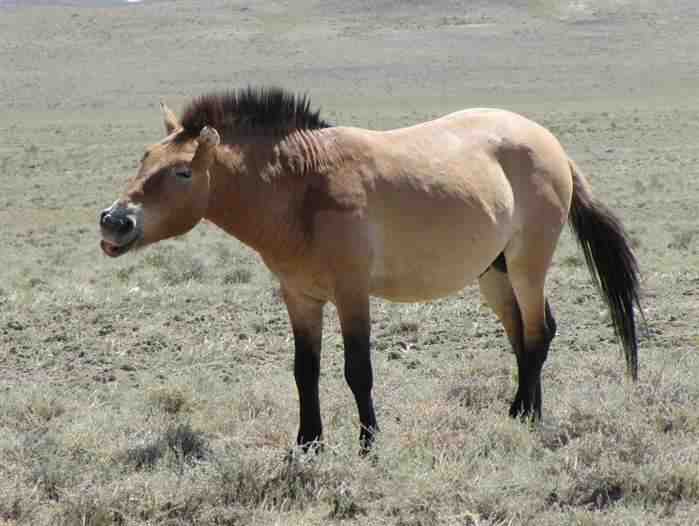Przewalski's Horse
IUCN
LCBasic Information
Scientific classification
- name:Przewalski's Horse
- Scientific Name:Wild horse, Asian wild horse, Mongolian wild horse, Junggar wild horse
- Outline:Ungulata
- Family:Perissodactyla Equine Equus
Vital signs
- length:210cm
- Weight:350kg
- lifetime:30years
Feature
The Return of an Endangered Species
Distribution and Habitat
Extinct in: Belarus, China, Germany, Kazakhstan, Lithuania, Poland, Russia and Ukraine.
Reintroduction: Mongolia and China.
Wild Przewalski's horses live in mountain grasslands on gentle slopes, open Gobi deserts, and deserts and Gobi with slightly better water and grass conditions.
Appearance
The body is strong and in proportion, the head is large and short and blunt, the neck is short and thick, the muzzle is sharp, the mouth is blunt, the teeth are thick, and the ears are smaller and slightly pointed than those of domestic horses. The ears are short and pointed, and the muzzle is spotted. The forelock is very short or absent, unlike the long forelock of domestic horses. The back is flat with a distinct dark back line extending from the shoulder to the tail along the spine; the limbs are short and thick, the hair on the inside of the legs is gray, often with two to five obvious black horizontal stripes, and the lower part of the calf is black, commonly known as "outing" legs.
Details
Przewalski's Horse is a large ungulate mammal.

Przewalski's horses are alert and good at running; they usually form a herd of 5-20 horses, led by a strong male horse, and live a nomadic life. They often drink water from springs and streams along fixed routes at dawn and dusk. They wander in groups of three, five or more than ten horses. Individuals in the group often clean each other's skin after eating. They usually stand in opposite directions, then stretch their heads to the side of their companions and gently nibble each other's nails, shoulders, backs, buttocks, etc. Both parties nibble the same part. When one party changes the part, the other party immediately changes accordingly. The cooperation is very tacit and perfect. Sometimes they also take care of themselves, including rolling, brushing themselves, and dispelling mosquitoes and flies, especially on sand. There are three postures for rest and sleep: standing, lying on the stomach, and lying on the side, but they are very vigilant and will be in a state of stress at the slightest movement. They are sensitive, vigilant, and have strong running ability. They are active day and night, but mostly at night.
In the 1960s, Mongolia first declared the wild Przewalski's horse extinct. Xinjiang, China, as the home of Przewalski's horses, was also basically declared extinct in the 1970s due to large-scale hunting by expedition teams from Russia, Germany, France and other countries, and the smuggling of 28 foals out of the country, coupled with large-scale killing in China. By 1985, there were only more than 700 surviving Przewalski's horses in 112 countries and regions including the United States, Britain, and the Netherlands, and they were raised in captivity and pens. In 1977, three people from Rotterdam, the Netherlands, founded the Przewalski's Horse Conservation Foundation, which has two main goals. One is to process the earlier Przewalski's horse pedigree record data through computers and establish a Mongolian wild horse pedigree record database; the other is to be the first to release Przewalski's horses back to nature.
In 1981, the Przewalski's Horse Conservation Foundation began to purchase Przewalski's horses, and tried to select wild horses with distant bloodlines for breeding. In 1986, the foundation began to cooperate with the Institute of Animal Evolutionary Morphology and Ecology of the Soviet Academy of Sciences, and it was expected that by 1988, the joint research would find suitable grassland reserves in the Soviet Union and Mongolia. Finally, a 24,000-acre Hustanuluru Grassland Reserve was established in Mongolia (officially established in 1998), and the first batch of 16 Mongolian wild horses were transported to the reserve in 1992 for wild release. Due to the smooth progress, the foundation sent two batches of 16 Mongolian wild horses to the reserve in 1994 and 1996. As of January 1, 1998, there were about 60 Przewalski's horses in the Hustanuluru Grassland. It was on this basis that in 2005, the Zoological Society of London formally applied to the World Conservation Union to change the protection status of Mongolian wild horses in the World Conservation Union Red List of Endangered Species from extinct in the wild to endangered.
On August 14, 1986, the Ministry of Forestry of China and the People's Government of the Xinjiang Uygur Autonomous Region formed a special agency to be responsible for the "return of wild horses to their hometowns" and built an area of 9,000 acres in Jimsar County, Xinjiang, the southern edge of the Junggar Basin, the largest wild horse breeding center in Asia. With the return of 18 wild horses from the United Kingdom, the United States, Germany and other countries, the history of no wild horses in the hometown of wild horses ended.
On September 28, 2021, the National Forestry and Grassland Administration released 6 Przewalski's horses in the Daqingshan National Nature Reserve in Inner Mongolia to further expand the wild population of Przewalski's horses. In November 2021, the National Forestry and Grassland Administration released the latest: After more than 30 years of protection, the breeding, wilding and release of Przewalski's horses, a first-class protected animal in China, have achieved remarkable results. The number of Przewalski's horses in China has exceeded 700. In March 2022, a Przewalski's horse appeared near the Wuwa Pond Wetland and haunted the Yangguan Wuwa Pond Wetland and the desert for 5 months.
Listed in the "Red List of Endangered Species of the World Conservation Union" (IUCN) 2014 ver3.1
Listed in the first level of China's "National Key Protected Wildlife List" (February 5, 2021).
Protect wild animals and stop eating game.
Maintaining ecological balance is everyone's responsibility!








